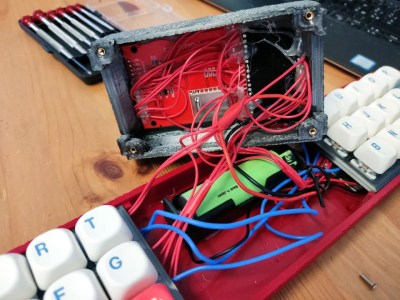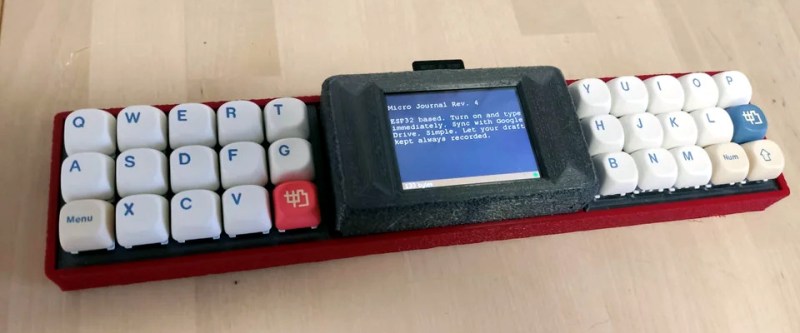Writing out a few thousand words is easy. Getting them in the proper order, now that’s another story entirely. Sometimes you’ll find yourself staring at a blank page, struggling to sieve coherent thoughts from the screaming maelstrom swirling around in your head, for far longer than you’d care to admit. Or so we’ve heard, anyway.
Unfortunately, there’s no cure for writer’s block. But many people find that limiting outside distractions helps to keep the mental gears turning, which is why [Un Kyu Lee] has been working on a series of specialized writing devices. The latest version of the Micro Journal, powered by the ESP32, goes a long way towards achieving his goals of an instant-on electronic notebook.
The writing experience on the Micro Journal is unencumbered by the normal distractions you’d have on a computer or mobile device, as the device literally can’t do anything but take user input and save it as a text file. We suppose you could achieve similar results with a pen and a piece of paper…but where’s the fun in that? These devices are more widely known as writerdecks, which is an extension of the popular cyberdeck concept of hyper-personalized computers.
 This newest Micro Journal, which is the fourth iteration of the concept for anyone keeping score, packs a handwired 30% ortholinear keyboard, a 2.8″ ILI9341 240×320 LCD (with SD card slot), ESP32 dev board, and an 18650 battery with associated charging board into a minimalist 3D printed enclosure.
This newest Micro Journal, which is the fourth iteration of the concept for anyone keeping score, packs a handwired 30% ortholinear keyboard, a 2.8″ ILI9341 240×320 LCD (with SD card slot), ESP32 dev board, and an 18650 battery with associated charging board into a minimalist 3D printed enclosure.
Unable to find any suitable firmware to run on the device, [Un Kyu Lee] has developed his own open source text editor to run on the WiFi-enabled microcontroller. While the distraction-free nature of the Micro Journal naturally means the text editor itself is pretty spartan in terms of features, it does allow syncing files with Google Drive — making it exceptionally easy to access your distilled brilliance from the comfort of your primary computing device.
While the earlier versions of the Micro Journal were impressive in their own way, we really love the stripped down nature of this ESP32 version. It reminds us a bit of the keezyboost40 and the EdgeProMX, both of which were entered into the 2022 Cyberdeck Contest.















Great hacking, put the available technology to a good use really.
Thanks! I was thinking what could be done with the parts that I had in a box and thought to put it together to make something works. As you have notices, personally the satisfying part was that I just used what was at hand at that time without going out of shopping.
“Unfortunately, there’s no cure for writer’s block.” ….. errr, yes there is, any hallucinogen such as psilocybin (‘magic mushrooms’), DMT (dimethyltryptamine), Salvia divinorum and mescaline (from the peyote cactus) should do the trick.
Or…. distraction free writerDeck. /s
Motivation.
A big angry dude telling you ‘write something by tomorrow, or I’ll kick you in the balls again.’ will get anybody generating LOC. Smart teams don’t want that code. Fire coders you have to kick anywhere to get work out of.
This device lacks a semicolon! You can’t code on that.
First Church of Christ, Computer Programmer: Burn the heretic!
Congregation: Semicolon!
“Writer’s block” made me think of a recent mental exercise I did recently. Have been learning a little guitar and wanted to write a simple song for a family event. I’m a good writer but every time I penned some lyrics, I felt like I was writing a book instead of writing song lyrics. But if you read many song lyrics, you realize that they seem to be the same … i.e., that when you read them, they don’t seem like they’d be any good in a song. Only once the interplay with the notes and the rhythm takes hold, do they seem to work.
Then I heard again the lyrics to “Burning Down The House” by the Talking Heads and recalled the band describing that those lyrics were just complete nonsense phrases they picked out of wherever. So I did the same by describing in my head the random things I saw on the side of the interstate as I was driving. It was remarkably effective. The “lyrics” came fast and furious … many of the phrases would have been quite usable in a song and seemed to “fit” better than when I was trying to “write” the lyrics.
Just wanted to add this in case it’s useful to any others. :)
I actually used to play in a band and write lyrics too. Never needed to use hallucinogens, I’d just delve into my sub conscious and dig into the things i was most afraid of. Suddenly , lyrics started to flow like out of nowhere but not necessarily suitable for a family event …. but depends on who your family are, I guess. I did once write a nice song about a girl i liked, but it was quite sad and haunting. Keep at it with the guitar !!
Realizing the part of the brain that operates beyond our conscious control is truly a moment of wonder and humility, a testament to the incredible capabilities of our minds and bodies that often surpass our expectations.
Why so many wires for the Querty?
It’s hand-wired. So, 10 columns + 3 rows for the matrix, making for at least 13 wires to cover the key switches. Add a few more for power switch or whatever else is lurking in there
https://github.com/unkyulee/micro-journal/blob/main/micro-journal-rev-4-esp32/readme.md#step-1-handwired-keyboard
Great build, I could be wrong, but I think you could expand the keyboard and use less wires but more diodes. 63 keys = 6 ESP pins, 31 keys = 5 pins.
Thanks! I noticed about charlieplexing recently and could have been a good trick to reduce the pin usage. Lately, I am working on a new iteration to use USB interface, which will no longer need for the key pad matrix. Just two wires and able to use the keyboards. Realized many more information that could have helped, only after the project was done. Community where I shared this project had a lot of feedback that are really been useful.
You’d end up with a lot of difficulty discerning when two keys are pressed. For some combinations maybe that could be beneficial, but if you’re pressing ‘a’ and ‘b’ you probably don’t really want a ‘c’ to appear.
People have been doing similar things with hacked up keyboard chips/boards in the Mame cabinet community for _decades_.
You might look there to avoid reinvention.
Thanks a lot for the post. I have always been a reader here, such a nice feeling to have my project as a post in hackaday. Yay!
i don’t understand why this project comes up so often. people want to avoid distractions so they replaced the task of writing with the task of creating a new device with excruciatingly bad ergonomics. at least this one uses a sensible CPU instead of just throwing a power-hungry pi at it.
there are a lot of good cheap laptops out there. just install a non-gui linux and hack the init scripts to go straight to vi. if you don’t have enough self control to avoid hacking your way out of your sandbox then you’ll just reach for your numerous unencumbered devices anyways. no substitute for having a decent keyboard and a screen that isn’t under your fingers.
I recognize that describing it “distraction-free” sounds a bit cheesy and sounds forced. However, the notion of being “distraction-free” somehow unveils possibilities that were previously unseen. Once experienced, this state becomes something I appreciate, as I’ve noticed subtle yet impactful differences it has brought to my life. Yet, conveying its effect solely through words feels insufficient. I’m not attempting to persuade anyone; I’m simply sharing my personal experience.
A cheap laptop with no-gui to achieve no distraction, can be an idea. I think my first iteration was basically that. It’s a bit difficult to find something with the mechanical keyboard sensation on those laptops. I just wanted a smallest form factor possible with the full keyboard switches, and I am ending up with 30 keys and a screen.
Feedback from the community has highlighted concerns regarding ergonomics and form factor. Consequently, for the next iteration, I’m contemplating separating the screen from the keyboard to allow for greater adjustability.
Ultimately, my projects are based on having fun for myself. If sharing it with the community attracts the interest of potential users and offers insights from a consumer perspective, it’s an added bonus for me.
As hackaday posts said, why not use a pen and paper? You know. Why not?
oh i’m with you on the beauty of distraction-free.
but let’s be honest. every time you pick this up, you’re not writing. instead, you’re debugging. you’re feature chasing. even while you write, you’re dreaming about debugging and feature chasing.
bespoke is the opposite of distraction-free. in my experience anyways.
but i am glad you have fun. that is indeed the ultimate test. i’m with you there too :)
“instead, you’re debugging. you’re feature chasing. even while you write, you’re dreaming about debugging and feature chasing” – do some people not do this with every single thing in their lives? This is a large part of why I’m a hacker!
Really on the spot! I feel that way every time I’m doing something and even when I’m not doing anything as well!
This is terrific! I was thinking of something similar to have my high school students write final exams on where there is no connectivity yet they can type instead of providing results in unrecognizable handwriting I then have to try to decode with the clock running towards marking being due. Congrats on a great design!
why not using FUZIX and full keyboard for vi
Great job!
Can the cursor (insertion point) be moved within the document, e.g. up/down/left/right?